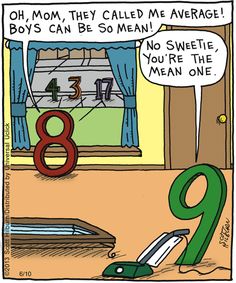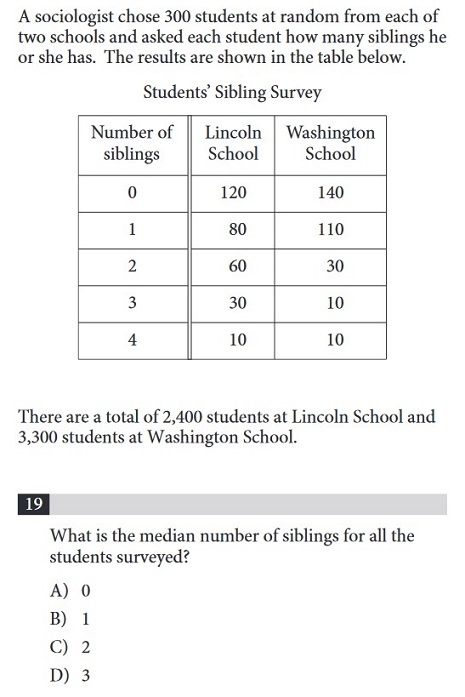
SAT statistics questions usually involve finding the mean, median, and/or mode(s) of a set of numbers. You have probably dealt with with these concepts in your high school math classes but, as always, the SAT likes to put their own special twist on simple concepts such as these.
Whether or not you are familiar with these terms and the techniques needed to find a mean, median, or mode, this guide is for you. SAT questions are always tricky and knowing how to handle their version of these types of questions will serve you well as you go through your test.
This will be your complete guide to SAT means, medians, and modes—what they mean, how you'll see them on the test, and how to solve even the most complicated of SAT statistics questions.
What Are Means, Medians, and Modes?
Before we look at how to solve these kinds of problems, let us define our terms:
A mean is the statistical average of a group of numbers, found by adding up the sum of the numbers and then dividing by the amount of numbers in the group.
What is the average test score for the class if five students received scores of: 92, 81, 45, 95, and 68?
We must find the sum of all the numbers and then divide that number by the total amount, which in this case is 5.
${(92+81+45+95+68)}/5$
$={381}/5$
$=76.2$
The mean (average) test score is 72.6.
The median in a set is the number directly in the middle of the set of numbers after they have been arranged in order. (Note: the number will be halfway into the set, but is NOT necessarily the mid-value.)
For instance, in a set of numbers {2, 4, 5, 47, 99}, the median would be 5 as it is in the middle of the set, despite the fact that 5 is NOT halfway between 2 and 99.
If you are given an even number of terms in the set, then you must take the mean (average) of both middle numbers.
Find the median value of the set of numbers {4, 12, 15, 3, 7, 10}.
First, arrange the numbers in order from least to greatest.
3, 4, 7, 10, 12, 15
We have an even number of terms in our set, so we must take the average of the two middle terms.
${(7+10)}/2$
$={17}/2$
$=8.5$
Our median is 8.5
The mode of a set of numbers is the number or numbers that repeat the most frequently.
In the set of numbers {3, 4, 3, 4, 4, 5, 12}, our mode is 4. Even though the number 3 occurred twice, the number 4 occurred three times and is thus our most frequently appearing number.
If each number in your set occurs only once, there is no mode.
In the set of numbers {1, 13, 8, 42, 11}, there is no mode, since no number repeats.
If multiple numbers in a set repeat the same number of times, your set will have more than one mode.
In the set {1, 2, 2, 2, 5, 5, 5, 7, 8, 8, 8}, we have three modes—2, 5, and 8. All three numbers occur exactly three times and no other numbers occur more frequently. Thus we have multiple modes.
 Ba-dum tss!
Ba-dum tss!
Typical Mean, Median, and Mode Questions
Because the statistical concepts of mean, median, and mode are fundamentally simple (and likely quite familiar to most of you), the SAT will try to complicate mean, median, and mode questions as much as they are able.
Unfortunately, these kinds of twists on simple concepts can come in a variety of different forms.
For mean questions, they may ask you for the average of a set with variables, or they may ask you to find the value to which the sum of a set of numbers must be raised or lowered in order to find a particular average.
Just keep in mind, that no matter how odd the question appears to be, the process for finding the mean is unchanging.
If $x$ is the average (arithmetic mean) of $m$ and 9, $y$ is the average of $2m$ and 15, and $z$ is the average of $3m$ and 18, what is the average of $x$, $y$, and $z$ in terms of $m$?
A) $m+6$
B) $m+7$
C) $2m+14$
D) $3m+21$
There are a lot of variables in this equation, but don't let them confuse you.
We already know that the average of two numbers is the sum of those two numbers divided by 2.
That means that:
$x = {m+9}/{2}$
$y= {2m+15}/{2}$
$z= {3m+18}/{2}$
Now we need to find the average of $x$, $y$, and $z$. The average of three numbers is the sum of those numbers divided by 3, or ${x+y+z}/{3}$.
Substituting the previous expressions for $m$ gives us:
$[{m+9}/{2} +{2m +15}/{2} + {3m+15}/{2}]/3$
We can simplify that fraction to
${6m+42}/{6}$
Or $m+7$.
Our final answer is B, $\bi m \bo{+} \bo 7$.
As for questions on medians, the SAT will often try to present you with a set of very large numbers or a set of numbers with some amount that are missing.

This question is asking about the median which, as you know, we find by sorting the numbers in ascending order.
There were a total of 600 data points collected (300 from each school) which means the median will be between the 300th and 301st numbers.
Fortunately, there's a way to solve the problem without having to write out 600 numbers! You can put the numbers into groups based on the information you're given in the chart.
For each number of siblings value, add the number of respondents from each of the two schools together. For example, 120 students from Lincoln School and 140 students from Washington School said they had no siblings, and $120+140=260$. So a total of 260 students have 0 siblings. Do this for each of the sibling values.
260 students have 0 siblings
190 students have 1 sibling
90 students have 2 siblings
40 students have 3 siblings
20 students have 4 siblings.
Now assign each of those groups values ordered from smallest (0 siblings) to largest (4 siblings) so that your data is properly sorted.
Values 1 through 260 will be 0.
Values 261 through 450 will be 1.
Values 451 through 540 will be 2.
Values 541 through 580 will be 3.
Values 581 through 600 will be 4.
Both the 300th and the 301st values are 1, so the median is 1.
Our final answer is B, 1.
The newest version of the SAT also includes logic questions. These questions don't require you to do any calculations, but you need to have a strong grasp of statistics to be able to answer them.
A study was done on the weights of different types of fish in a pond. A random sample of fish were caught and marked in order to ensure that none were weighed more than once. The sample contained 150 largemouth bass, of which 30% weighed more than 2 pounds. Which of the following conclusions is best supported by the sample data?
A) The majority of all fish in the pond weigh less than 2 pounds.
B) The average weight of all fish in the pond is approximately 2 pounds.
C) Approximately 30% of all fish in the pond weigh more than 2 pounds.
D) Approximately 30% of all largemouth bass in the pond weigh more than 2 pounds.
For logic questions like these, the best way to attack them is to read through the information you're given then, go through each answer choice and determine if it's true.
In the question, we're told that:
- A random sample of fish in a pond were caught, none more than once
- The sample included 150 largemouth bass
- 30% of those largemouth bass weighed more than 2 pounds
Now let's go through the answer choices.
A: This is incorrect because it says the majority of all fish weigh less than 2 pounds. We don't know if this is true or not because the question only gives us information on the weight of largemouth bass. We don't know how much the other types of fish in the pound weigh.
B: Again, we can't answer questions about all the fish in the pond because we are only given information on largemouth bass.
C: Once again, we can't make generalizations about all the fish in the pond. If the question was just asking about largemouth bass, then it'd be true, since it matches with the data we were given, but since it doesn't, it's incorrect.
D: This choice asks only about largemouth bass, which is a good start. And, yes, this answer choice fits with the information we were given in the question. Since 30% of the random sample of largemouth bass collected weighed more than 2 pounds, it's logical to conclude that 30% of all the largemouth bass in the pound weigh more than 2 pounds. This is the correct answer!
This question was testing your knowledge of what assumptions are logical and which are not based on the data you're given. Since we were only given information about the weight of largemouth bass, only statements about largemouth bass specifically have the possibility of being supported by our data.
Our final answer is D.
And lastly, mode questions are actually quite rare on the SAT. You should know what a "mode" means on the off chance that you will see a mode question on the test, but chances are you will only be asked about means and/or medians.
 Though the SAT may try to vary their questions, the principles behind them remain the same.
Though the SAT may try to vary their questions, the principles behind them remain the same.
Ready to go beyond just reading about the SAT? Then you'll love the free five-day trial for our SAT Complete Prep program. Designed and written by PrepScholar SAT experts, our SAT program customizes to your skill level in over 40 subskills so that you can focus your studying on what will get you the biggest score gains.
Click on the button below to try it out!
How to Solve Mean, Median, and Mode Questions
Because these questions often seem straightforward, it can be easy to find yourself rushing through them. But as you go through your test, remember to keep these SAT math tips in mind:
#1: Always (always!) make sure you are answering the right question
Because the SAT will ask you to find means more than medians or modes, it is incredibly common for students who are rushing through the SAT to read "mean" when the question is actually asking for a "median." If you're trying to rush, it can become second nature to glance at an m-word and start in immediately on solving the problem.
Unfortunately, the test makers know that people will make errors like this and they will provide bait answers for anyone who makes this kind of mistake. As always when taking the SAT math sections, double-check that you are answering precisely the right question before you start in on solving the question (or at least before bubbling in your answer!).
#2: Write It Out
Make sure you take the time to rearrange your set of numbers in order when dealing with medians and modes, and make sure you write out your equations when dealing with means. It can be tempting to solve problems like these in your head, but a single misplaced digit is the difference between a correct answer and a wrong answer penalty.
In order to avoid making careless mistakes, always take a moment to write out your problem. It will not take as long as you think to reorganize your values and it will almost always highlight the path towards perfection.
#3: Use PIA/PIN When Necessary
If you find yourself stuck on a problem and have some extra time to spare, don't hesitate to use the strategies of plugging in answers or plugging in numbers where applicable. Always keep in mind that it will often take you a little longer to solve a problem using these techniques, but doing so will almost always lead you to the right answer.
For example:
The average (arithmetic mean) of 6, 19, and $x$ is 19. What is the value of $x$?
A) 19
B) 25
C) 31
D) 32
Let us say this was a problem you found yourself stuck on, but you luckily had some spare time before the section was over. Well, now is the time to use PIA!
We will be replacing our answer options with the value of $x$ and solving the problem as normal. As usual with PIA, let us start with the middle answer choice and go up or down from there.
This means that we will plug in answer choice C, 31, in place of our $x$ value.
We are trying to find the mean of 3 numbers, 6, 19, and 31, and seeing if we can get 19. So let us find the mean:
${6+19+31}/3$
$={56}/3$
$=18.67$
Our mean is just slightly too small. This means that we can eliminate answer choice C as well as answer choices A and B (as they are even smaller and will thus produce an even smaller mean).
Our answer is likely going to be D, as E is much larger and will give us a far greater mean than 19. So let us test answer choice D, 32, to be sure.
${6+19+32}/3$
$={57}/3$
$=19$
Success! Answer choice D is correct.
Our final answer is D, 32.
 There are a variety of escape hatches when solving mean/median/mode problems, so never fear!
There are a variety of escape hatches when solving mean/median/mode problems, so never fear!
Test Your Knowledge
Now to test your statistics know-how on real SAT math problems!
1.
10, 18, 4, 15, 3, 21, $x$
If $x$ is the median of the 7 numbers listed above, which of the following could be the value of $x$?
A) 5
B) 8
C) 9
D) 14
2.
If the average (arithmetic mean) of $t$ and $t+2$ is $x$ and if the average of $t$ and $t-2$ is $y$, what is the average of $x$ and $y$?
A) 1
B) $t/2$
C) $t$
D) $t+1/2$
3.
A survey was taken of the value of homes in a county, and it was found that the mean home value was $\$ 165,000$ and the median home value was $\$ 125,000$. Which of the following situations could explain the difference between the mean and median home values in the county?
A) The homes have values that are close to each other.
B) There are a few homes that are valued much less than the rest.
C) There are a few homes that are valued much more than the rest.
D) Many of the homes have values between $\$ 125,000$ and $\$ 165,000$.
4.
The mean score of 8 players in a basketball game was 14.5 points. If the highest individual score is removed, the mean score of the remaining 7 players becomes 12 points. What was the highest score?
A) 20
B) 24
C) 32
D) 36
Answers: D, C, C, C
Answer Explanations:
1. This question is asking about the median, so let us first start by arranging our numbers in ascending order.
3, 4, 10, 15, 18, 21
We are told that x is our median, so it must lie in the middle of our set. This puts it between 10 and 15.
3, 4, 10, $x$, 15, 18, 21
This means that the only answer choice x could possibly be is D, 14. All the other answer choices are too large or too small.
Our final answer is D, 14.
2. Because we are working with variables, we have two ways we can solve this problem—with algebra or using plugging in numbers. Let us go through both methods.
Method 1: Algebra
We are told that the mean of $t$ and $t+2$ equals $x$, so let us find the value of $x$ by manipulating the mean of $t$ and $t+2$.
${t+(t+2)}/{2}=x$
${2t+2}/{2}=x$
We can reduce the value of the fraction here, since $2t+2$ can be divided by 2. Which means we are left with:
$t+1=x$
Now let us use the same process for y, which we are told is the mean of $t$ and $t−2$
${t+(t-2)}/{2}=y$
${2t-2}/{2}=y$
Again, we can reduce our fraction, since $2t−2$ can be divided by 2. This gives us:
$t−1=y$
Now, we have values for both $x$ and $y$, so let us put them together to find their mean.
${(t+1)+(t-1)}/{2}$
$={2t}/{2}$
$=t$
The mean of $x$ and $y$ is $t$.
Our final answer is C, $t$.
Method 2: Plugging in numbers
Alternatively, we can skip having to use algebra and plug in our own number for $t$ in order to solve the problem. Let us say that $t=10$ and solve the problem from there. (Why 10? Why not!)
This means that the mean of $t$ and $t+2$ still equals $x$. So:
${t+(t+2)}/{2}=x$
${10+(10+2)}/{2}=x$${22}/{2}=x$
$11=x$
And we will use the same value for $t$ and the same process to find $y$:
${t+(t-2)}/{2}=y$
${10+(10-2)}/{2}=y$
${18}/{2}=y$
$9=y$
Now, we can find the mean of $x$ and $y$.
${11+9}/{2}$
$=20/2$
$=10$
And, since we said that $t=10$, the mean of $x$ and $y$ also equals $t$.
Our final answer is C, $t$.
3. This is a logic question, so we'll have to reason through it rather than doing calculations. First let's go over the information we're given.
The mean and media of a set of data are equal when the data has a perfectly symmetrical distribution (such as a normal distribution).
If the mean and median aren't equal to each other, that means the data isn't symmetrical and that there are outliers.
Outliers are a small group of values that are significantly smaller or larger than the other values in the data.
When there are outliers in the data, the mean will be pulled in their direction (either smaller or larger) while the median remains the same.
In this problem, the mean is larger than the median.
That means the outliers are several homes that are significantly more expensive than the rest, since these outliers push the mean to be larger without affecting the median.
Choice A is incorrect because if the house values were all similar to each other, the mean and median would be similar in value.
Choice B is incorrect because if the outliers were valued at much less than the rest of houses, the mean would be smaller than the median which is the opposite of what is happening.
Choice D is incorrect because if most of the homes were worth between $\$ 125,000$ and $\$ 165,000$, then the mean and median would likely both be in the middle of that range which isn't the case; they're on the ends of that range.
Therefore, our final answer is C: there are a few homes that are valued much more than the rest.
4. If the mean score of 8 players is 14.5, then the total of those 8 scores is $14.5 * 8 =116$.
If the mean of 7 scores is 12, then the total of those 7 scores is $12 * 7 =84$.
Since the set of 7 scores was created by removing the highest score from the set of 8 scores, the difference between the total of all 8 scores and the set of 7 scores is equal to the removed score.
$116-84 = 32$
Our final answer is C, 32.

You finished your statistics problems, whoo! The puppy is happy.
The Take Aways
Though you will see mean, median, and mode questions about two to three times per test, the questions themselves are often quite simple once you know your way around the techniques needed to solve them.
Never hesitate to use PIA or PIN if you have the time to spare and if you feel uncomfortable with algebra alone. Otherwise, make absolutely sure you are answering the proper question and don't take for granted that these questions are simple (a careless error will still lose you precious points!).
Just remember to keep your mind sharp and your work organized, and you'll be able to tackle SAT statistics problems in no time.
What's Next?
Now that you've done your paces on SAT statistics questions, it's time to make sure you've got the rest of the SAT math topics well in hand. Are you all caught up with your probabilities? Your formulas? Your lines and angles? We've got guides that cover all the SAT math you'll need come test day.
Need to brush up on the basics (particularly for the SAT No-Calculator Math section)? Use our guides to review longhand multiplication and how to add and subtract fractions.
Don't know what score to aim for? Check out how to gauge your current score level and how that stacks up for your schools.
Looking to get a 600 on SAT math? Look to our guide on how to improve your SAT math score.
Trying for a perfect score? If you're already at a 600 or above, check out our guide to getting a perfect 800 on the SAT math, written by a perfect-scorer.
Want to improve your SAT score by 160 points?
Check out our best-in-class online SAT prep program. We guarantee your money back if you don't improve your SAT score by 160 points or more.
Our program is entirely online, and it customizes what you study to your strengths and weaknesses. If you liked this Math strategy guide, you'll love our program. Along with more detailed lessons, you'll get thousands of practice problems organized by individual skills so you learn most effectively. We'll also give you a step-by-step program to follow so you'll never be confused about what to study next.
Check out our 5-day free trial:
Have friends who also need help with test prep? Share this article!

Courtney scored in the 99th percentile on the SAT in high school and went on to graduate from Stanford University with a degree in Cultural and Social Anthropology. She is passionate about bringing education and the tools to succeed to students from all backgrounds and walks of life, as she believes open education is one of the great societal equalizers. She has years of tutoring experience and writes creative works in her free time.



































 Holly R.
Holly R.